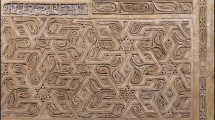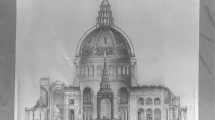Abstract
The architectural complexity of Hagia Sophia, a grand monument erected by Justinian in Constantinople, has been a topic of substantial investigation across diverse disciplines such as architecture, art history, and archaeology. Research efforts focused on elucidating the geometric relationships intrinsic to the monument's design, providing invaluable insights into the philosophical and symbolic influences that shaped its construction. However, despite significant strides, a comprehensive understanding of Hagia Sophia’s complex geometric design remains elusive due to the inherent challenges in integrating diverse geometric patterns into a unified model. The current study aims to bridge this gap through a comparative analysis of the mathematical and geometric principles used in the design of Hagia Sophia with the inscribed in stone complex geometrical design found in the Octagon at the Galerious Complex in Thessaloniki and has recently been recognised as the conceptual design for the Kastas monument at Amphipolis. By exploring parallels and creating comparisons, the article deepens the understanding of the design intent and geometric foundations that underpin the enduring architectural legacy of Hagia Sophia.












Similar content being viewed by others
Data availability
All relevant data supporting the findings of this study are available within the article. The raw data, as well as any additional materials and datasets generated during the course of this research, are available upon reasonable request from the corresponding author.
Notes
As stated in Psalms, 103:24 (Holy Bible, New revised Standard Version, 1989) ὡς ἐμεγαλύνθη τὰ ἔργα σου, Κύριε· πάντα ἐν Σοφίᾳ ἐποίησας ἐπληρώθη ἡ γῆ τῆς κτίσεώς σου, translation: How great are thy works, O Lord? thou hast made all things in wisdom: the earth is filled with thy riches.
Translated with the approval of the author: “A visitor familiar with the architects' philosophical culture could grasp the deeper meaning inside the church, while others could still sense the divine power radiating from above, drawing their gaze and spirit upwards towards its origin.”
References
Afanasiev, K.N., 1952. Гeoмeтpичecкий aнaлиз xpaмa cв. Coфии в Кoнcтaнтинoпoлe (Geometric analysis of the temple of St. Sophia in Constantinople) Bизaнтийcкий вpeмeнник 5(21): 207–215.
Athanasiou, Fani, Venetia Malama, Maria Miza, and Maria Sarantidou. 2015. Η αποκατάσταση των ερειπίων του Γαλεριανού συγκροτήματος στη Θεσσαλονίκη (1994–2014). Tεκμηρίωση και επεμβάσεις (The Restoration of the ruins of the Galerian Complex in Thessaloniki (1994– 2014). Documentation and interventions). Thessaloniki: Hellenic Ministry of Culture, Education and Religious Affairs, Ephorate of Antiquities of Thessaloniki City.
Antoniades, E.M., 1908. Ekphrasis tês Hagias Sophias, II. Leipzig-Athens.
Arpat, A., 1983. Divine Numbers in the Dimensions of Hagia Sophia in Istanbul. Ayasofya Müzesi Yıllığı, 9: 36–53.
Bork, R., 2014. Dynamic Unfolding and the Conventions of Procedure: Geometric Proportioning Strategies in Gothic Architectural Design. Architectural Histories, 2(1): 1–20.
Cutler, A., 1966. Structure and Aesthetic at Hagia Sophia in Constantinople. The Journal of Aesthetics and Art Criticism 25(1): 27-35.
Downey, G., 1946 Byzantine Architects: Their Training and Methods. Byzantion 18: 99–118.
Fountas, P., 2008. Protaton church: history and architectural metamorphosis. PhD Thesis, National Technical University of Athens.
Hadjitryphonos, E., 2010. Presentations and Representations of Architecture in Byzantium: the Thought Behind the Image. In: S. Ćurčić / E. Hadjitryphonos (eds.), Architecture as Icon: Perception and Representation of Architecture in Byzantine Art (Princeton, London 2010): 74–113.
Hauck, O., Noback, A. & Grobe, L., 2013. Computing the ‘Holy Wisdom.’ https://doi.org/10.1007/978-3-642-28021-4_22.
Holy Bible: New Revised Standard Version. (1989). New York: Oxford University Press
Hoffmann, V. & Theocharis, N., 2002. Der geometrische Entwurf der Hagia Sophia in Istanbul: Erster Teil. Istanbuler Mitteilungen 52: 393–428.
Hoffmann, Volker., 2010. Der geometrische Entwurf der Hagia Sophia in Istanbul. Bilder einer Ausstellung. In: Kirkbride, R. (eds) Geometries of Rhetoric. Nexus Network Journal vol 12,3. Birkhäuser, Basel. https://doi.org/10.1007/978-3-0346-0522-9_13.
Gerhold, V.E., 2018. Defeating Solomon: Intertextuality and Symbolism in the Legend of Hagia Sophia. Scripta Mediaevalia, 11(1), pp.11-38.
Cho, H., Park, J.H. & Yu, D., 2015. A Study on Geometric Analysis of Hagia Sophia. Journal of the architectural institute of Korea planning & design 31: 97-104.
Jabi, W. & Potamianos, I., 2007. Geometry, Light, and Cosmology in the Church of Hagia Sophia. International Journal of Architectural Computing, 5, pp. 304-319.
Junecke, H., 1983. Proportionen frühchristlicher Basiliken des Balkan im Vergleich von zwei unterschiedlichen Meßverfahren: Proportionen der Hagia Sophia in Istanbul. Tübingen: Wasmuth. Kostof, S., 1977. The Architect in the Middle Ages, East and West. In: S. Kostof (ed.), The Architect: Chapters in the History of the Profession. New York, Oxford: Oxford University Press: 59–95.
Kostof, S., 1977. The Architect in the Middle Ages, East and West. In: S. Kostof (ed.), The Architect: Chapters in the History of the Profession. New York, Oxford: Oxford University Press, pp. 59–95.
Lefantzis, M. 2023. L’architettura del tumulo di kasta di anfipoli. In Alessandro magno, edited by Filippo Coarreli and Eugenio Lo Sardo. Classical Archaeology, Architecture, History of architecture, Ancient Greek Architecture, Ancient Architecture and Construction History.
Lozanovska, Mirjana. 2010. Hagia Sofia (532-537AD): A study of centrality, interiority and transcendence in architecture. The Journal of Architecture 15: 425-448.
Mainstone, R.J., 1988. Hagia Sophia: Architecture, Structure and Liturgy of Justinian’s Great Church. London: Thames and Hudson.
Maillard, E., 1962. Les Cahiers du Nombre d’ Or, II, Eglises Byzantines, Public avec le concours du centre National de la Recherche scientifique, Paris.
Meek, H.A., 1952. The Architect and His Profession in Byzantium. Journal of the Royal Institute of British Architects 59: 216–220.
Millet, G., 1923. La Coupole primitive de Sainte-Sophie. Revue belge de philologie et d'histoire 2(4): 599-617.
O'Meara, J.D., 2017. Cosmology and Politics in Plato’s Later Works. Cambridge: Cambridge University Press.
O’Meara, J.D.,2023. Symbolisme Géométrique Néoplatonicien dans l’Architecture de Sainte-Sophie. In D. Lauritzen (Ed.), Sainte-Sophie de Constantinople au VIe siècle: archéologie et littérature, Travaux et Mémoires, Vol. 27, Paris.
Ousterhout, R., 2019. Eastern Medieval Architecture: The Building Traditions of Byzantium and Neighboring Lands. Oxford: Oxford University Press. https://doi.org/10.1093/oso/9780190272739.001.0001.
Ousterhout, R., 1999. Master Builders of Byzantium, Princeton University Press.
Pantelic, B., 1999. Applied Geometrical Planning and Proportions in the Church of Hagia Sophia in Istanbul. Istanbuler Mitteilungen 49: 493–515.
Petronotis, A., 1983. Der Architekt in Byzanz. Bauplanung und Bautheorie der Antike 4: 329–342.
Potamianos, I. and Jabi, W., 2006. Interactive Parametric Design and the Role of Light in Byzantine Churches. In: 24th Conference on Education in Computer Aided Architectural Design in Europe, Volos, Thessaly, Greece. DOI: https://doi.org/10.52842/conf.ecaade.2006.798.
Savvides, D., 2021. The Conceptual Design of the Octagon at Thessaloniki. Nexus Network Journal 23: 395–432.
Savvides, D., 2023. Observations on the Geometry of the Monument at the Kasta Tumulus at Amphipolis.Nexus Network Journal 25: 607–632.
Scheja, G., 1962. Hagia Sophia und Templum Salomonis. Istanbuler Mitteilungen 12: 44–58.
Schibille, N., 2016. Hagia Sophia and the Byzantine aesthetic experience. London: Routledge.
Svenshon, H., 2009. Heron of Alexandria and the Dome of Hagia Sophia in Istanbul. Proceedings of the Third International Congress on Construction History. Berlin: NEUNPLUS1: 1387–1394.
Svenshon, H. & Stichel, R.H.W., 2006. ‘Systems of Monads’ as Design Principle in the Hagia Sophia: Neo-Platonic Mathematics in the Architecture of Late Antiquity. Nexus Conference 2006: Relationships between Architecture and Mathematics: 111–120.
Svenshon, H. 2010, Das Bauwerk als “Aistheton Soma”. Eine Neuinterpretation der Hagia Sophia im Spiegel Antiker Vermessungslehre und Angewandter Mathematik, in F. Daim, J. Drauschke (eds.), Sonderdruck aus Byzanz – das Römerreich im Mittelalter, 2, 1, Vienna, Römisch-Germanisches Zentralmuseums, 59–95.
Tavano, S., 1980. Unità e originalità dell'architettura Giustinianea, ACIAC X, II, pp. 543–561.
Van Nice, R.L., 1965. Saint Sophia in Istanbul. An Architectural Survey. Dumbarton Oaks Center for Byzantine Studies, Washington D.C.
Acknowledgements
The author would like to express his profound gratitude to Prof. Dimosthenis Avramidis of the Athens School of Fine Art for his invaluable contributions to my study of Byzantine art. His expertise and insightful discussions have significantly enriched the author’s understanding and appreciation of this complex artistic tradition. Furthermore, the author extends his heartfelt thanks to Prof. Dominic J. O'Meara for his kindness in providing early access to his published works, and for his guidance in Neoplatonic studies.
Author information
Authors and Affiliations
Corresponding author
Additional information
Publisher's Note
Springer Nature remains neutral with regard to jurisdictional claims in published maps and institutional affiliations.
About this article
Cite this article
Savvides, D. Hagia Sophia in Constantinople: Unveiling Its Integrated Conceptual Design Through Comparative Analysis. Nexus Netw J 26, 325–352 (2024). https://doi.org/10.1007/s00004-023-00758-5
Accepted:
Published:
Issue Date:
DOI: https://doi.org/10.1007/s00004-023-00758-5




